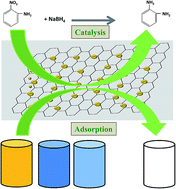Our official English website, www.x-mol.net, welcomes your feedback! (Note: you will need to create a separate account there.)
Synthesis and characterization of graphene oxide sheets integrated with gold nanoparticles and their applications to adsorptive removal and catalytic reduction of water contaminants†
RSC Advances ( IF 3.9 ) Pub Date : 2018-01-17 00:00:00 , DOI: 10.1039/c7ra12030c H Naeem 1 , M Ajmal 2 , S Muntha 1 , J Ambreen 3 , M Siddiq 1
RSC Advances ( IF 3.9 ) Pub Date : 2018-01-17 00:00:00 , DOI: 10.1039/c7ra12030c H Naeem 1 , M Ajmal 2 , S Muntha 1 , J Ambreen 3 , M Siddiq 1
Affiliation

|
Here, we report the facile synthesis of graphene oxide–gold (GO–Au) nanocomposites and their use as adsorbents for the removal of toxic industrial dyes from water and as catalysts for the individual and simultaneous reduction of a dye and a nitro compound in aqueous medium. GO sheets were prepared using a modified Hummers method while Au nanoparticles were integrated on GO sheets by reducing Au(III) ions on the surfaces of GO sheets using sodium citrate as a reducing agent. The prepared composite was characterized with field emission scanning electron microscopy (FESEM), transmission electron microscopy (TEM), elemental dispersive X-ray analysis (EDX), X-ray diffraction (XRD), Fourier transform infra-red (FT-IR) spectroscopy and thermal gravimetric analysis (TGA). The GO–Au nanocomposite demonstrated efficient adsorption capacities and recyclability for malachite green (MG) and ethyl violet (EV) dyes. The effects of various experimental parameters including temperature, pH, contact time, and adsorbent dose were studied. From the simulation of experimental data with different adsorption isotherms and kinetic models it was found that the adsorption of both the dyes followed the Freundlich adsorption model and a pseudo-second order kinetic model, respectively. Moreover, the adsorbent showed better recyclability for both dyes without any compromise on the removal efficiency. Similarly, the catalytic performance for the reduction of 2-nitroaniline (2-NA) has been investigated in detail by using the prepared nanocomposite as a catalyst. Most importantly, we reported the simultaneous adsorption of cationic and anionic dyes from water using the prepared nanocomposite as well as the simultaneous catalytic reduction of a mixture of EV and 2-NA. So, considering the facile synthesis process and the efficient removal of a variety of dyes and the catalytic performance this work opens up a tremendous opportunity to bring GO based nanocomposites from experimental research to practically applied materials for wastewater treatment.
中文翻译:

与金纳米颗粒结合的氧化石墨烯片的合成和表征及其在吸附去除和催化还原水污染物中的应用†
在这里,我们报道了氧化石墨烯-金 (GO-Au) 纳米复合材料的简便合成及其作为吸附剂从水中去除有毒工业染料的用途,以及作为单独和同时还原染料和硝基化合物在水溶液中的催化剂。中等的。GO 片材使用改进的 Hummers 方法制备,而 Au 纳米颗粒通过还原 Au( III ) 集成在 GO 片材上) 使用柠檬酸钠作为还原剂的 GO 片材表面上的离子。用场发射扫描电子显微镜(FESEM)、透射电子显微镜(TEM)、元素色散X射线分析(EDX)、X射线衍射(XRD)、傅里叶变换红外(FT-IR)对制备的复合材料进行表征光谱和热重分析(TGA)。GO-Au 纳米复合材料表现出对孔雀石绿 (MG) 和乙基紫 (EV) 染料的高效吸附能力和可回收性。研究了各种实验参数的影响,包括温度、pH、接触时间和吸附剂剂量。通过对不同吸附等温线和动力学模型的实验数据的模拟,发现两种染料的吸附分别遵循 Freundlich 吸附模型和准二级动力学模型。此外,吸附剂对两种染料都表现出更好的可回收性,而对去除效率没有任何影响。同样,通过使用制备的纳米复合材料作为催化剂,对还原 2-硝基苯胺 (2-NA) 的催化性能进行了详细研究。最重要的是,我们报道了使用制备的纳米复合材料同时从水中吸附阳离子和阴离子染料,以及同时催化还原 EV 和 2-NA 的混合物。所以,
更新日期:2018-01-17
中文翻译:

与金纳米颗粒结合的氧化石墨烯片的合成和表征及其在吸附去除和催化还原水污染物中的应用†
在这里,我们报道了氧化石墨烯-金 (GO-Au) 纳米复合材料的简便合成及其作为吸附剂从水中去除有毒工业染料的用途,以及作为单独和同时还原染料和硝基化合物在水溶液中的催化剂。中等的。GO 片材使用改进的 Hummers 方法制备,而 Au 纳米颗粒通过还原 Au( III ) 集成在 GO 片材上) 使用柠檬酸钠作为还原剂的 GO 片材表面上的离子。用场发射扫描电子显微镜(FESEM)、透射电子显微镜(TEM)、元素色散X射线分析(EDX)、X射线衍射(XRD)、傅里叶变换红外(FT-IR)对制备的复合材料进行表征光谱和热重分析(TGA)。GO-Au 纳米复合材料表现出对孔雀石绿 (MG) 和乙基紫 (EV) 染料的高效吸附能力和可回收性。研究了各种实验参数的影响,包括温度、pH、接触时间和吸附剂剂量。通过对不同吸附等温线和动力学模型的实验数据的模拟,发现两种染料的吸附分别遵循 Freundlich 吸附模型和准二级动力学模型。此外,吸附剂对两种染料都表现出更好的可回收性,而对去除效率没有任何影响。同样,通过使用制备的纳米复合材料作为催化剂,对还原 2-硝基苯胺 (2-NA) 的催化性能进行了详细研究。最重要的是,我们报道了使用制备的纳米复合材料同时从水中吸附阳离子和阴离子染料,以及同时催化还原 EV 和 2-NA 的混合物。所以,



























 京公网安备 11010802027423号
京公网安备 11010802027423号